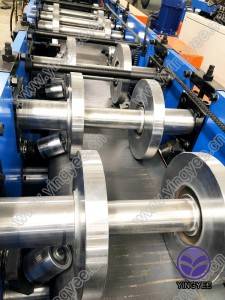
Understanding the Double Layer Roofing Sheets Forming Machine
The construction and building materials industries have seen a significant evolution in machinery that simplifies production while enhancing quality. One such innovation is the double layer roofing sheets forming machine, a piece of equipment that has revolutionized how roofing sheets are manufactured. This article delves into the functionalities, advantages, and applications of this machine.
What is a Double Layer Roofing Sheets Forming Machine?
A double layer roofing sheets forming machine is a multipurpose machine capable of producing two types of roofing sheets in a single pass. This versatile equipment utilizes advanced technology to create high-quality metal sheets that cater to various construction needs. Typically, the machine can produce sheets like trapezoidal and corrugated profiles simultaneously or one after the other, depending on the configuration chosen by the operator.
How Does It Work?
The process of double layer sheet forming begins with the feeding of raw metal coils into the machine. These coils are unrolled and fed into a series of rolls that shape them into the desired profiles. The machine is equipped with rollers designed to create two varying profiles, allowing for flexibility in production. Additionally, the system often involves a hydraulic cutting mechanism that allows for precise sizing and cuts after the desired length is achieved.
One of the key features of this machinery is its control panel, which enables operators to select different sizes, profiles, and specifications for the sheets. Advanced models may include features like computerized controls and automation, making the operation easier and more efficient.
Advantages of Using Double Layer Roofing Sheets Forming Machines
1. Cost Efficiency By producing two types of roofing sheets simultaneously, the double layer roofing sheets forming machine minimizes production costs. Manufacturers can save on material costs and reduce labor expenses as fewer machines are required.

2. Space Saving The compact design of a double layer forming machine requires less floor space compared to having multiple single-layer machines. This allows manufacturers to optimize their production areas effectively.
3. High Production Capacity The ability to produce two profiles in one cycle enhances production rates. This means manufacturers can meet higher demands without investing in additional equipment.
4. Versatility The machine is adaptable to various sheet profiles, making it suitable for different construction applications. Whether for residential roofs, commercial buildings, or industrial structures, this machine can cater to varied demands.
5. Quality Control Advanced technologies used in the formation of roofing sheets ensure consistent quality. The precision of the rolls and cutting ensures uniform thickness and dimensional accuracy, leading to better performance and aesthetics.
Applications
Double layer roofing sheets are prevalent in a variety of construction projects. They are used widely in residential buildings, commercial structures, warehouses, and industrial facilities. The two layers can enhance insulation properties, making them efficient in terms of energy consumption. Moreover, the aesthetic appeal of having dual-profiles allows architects and builders to create visually appealing designs.
The machine's capability to produce customized sheets means it can cater to specific project requirements. Whether it’s for curving roofs or complex architectural designs, the double layer roofing sheets forming machine can adapt to the needs of modern construction.
Conclusion
In conclusion, the double layer roofing sheets forming machine represents a significant advancement in roofing sheet production technology. Its cost-efficiency, space-saving design, high production capacity, and versatility make it an invaluable asset in the building materials industry. As the demand for sustainable and efficient building solutions continues to grow, embracing such innovative machines will undoubtedly play a crucial role in shaping the future of construction.